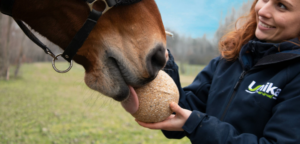
UNIKA BALLS: THE SUPPLEMENT THAT COMBINES FUN AND WELL-BEING
If you have ever walked through the stables or along…
Feed and products in 25kg bags excluded
Bank transfer | Paypal | Credit cards

Botanical name: Arnica montana
Family: Asteraceae
Used part: flower
Main effects: anti-inflammatory, analgesic, anti-ecchymosis, anti-microbial.
Therapeutic uses: Arnica montana is used in case of haematomas, sprains, muscular and articular pain, local inflammations, insects bites etc…
Arnica montana is an extremely well-known plant in human phytotherapy and it is also quite commonly used in veterinary phytotherapy. These days, there’s a lot of talk about this plant and there are more and more mountain arnica-based products on the market. But do we really know what we are talking about and how this plant actually looks like?
Arnica montana is a perennial herbaceous plant with a simple, hairy stem up to 50 cm tall, and a deep, creeping rhizome. Each stem only bears one yellow-orange flower and the flowering season goes from May to late July.
Mountain arnica is manly known for its properties as a product for external use. Thanks to its anti-inflammatory and painkilling effects, it can be a valuable ally in relieving local pain. But that’s not all: Arnica montana is also very useful in treating bruises (ecchymoses) and in facilitating post-trauma swelling reabsorption. According to the most important phototherapy books, mountain arnica is mainly used in case of:
In the equine world, which is our main field of interest, Arnica montana is a valuable ally in treating post-training articular pain and can be used as an anti-fatigue gel for legs after every training and competition.
Therefore, a quality mountain arnica-based cream can be quite useful to:
It is very important to bear in mind that mountain arnica-based creams always need to be administered on intact skin.
The connection between Arnica montana’s effects and its active constituents is not yet fully known, but it seems that this plant’s properties are due to the presence of sesquiterpenes lactones and helenalin.
Creams should not contain high concentrations of arnica, for an excessive amount of this plant could cause skin sensitisation. It is suggested to choose creams based on good quality raw-materials: in that case, a 20-25% arnica concentration will be effective enough.

If you have ever walked through the stables or along…

Colic is one of the most common and delicate issues in horse care.

Thanks to its anti-inflammatory, anti-oedemigenous and pain-relieving properties, it is perfect for protecting horses’ osteoarticular well-being.

The use of clay dates back to very ancient times and even today it has not lost its fame as a natural remedy with a thousand uses.

The warm season is upon us and for many riders it is time to take the clipper in hand…

Here we are at our second meeting with our Unika Blog Naturopathy section. I am Sara Maiani, specialized in Natural Medicine, Clinical Phytotherapy and Naturopathy.